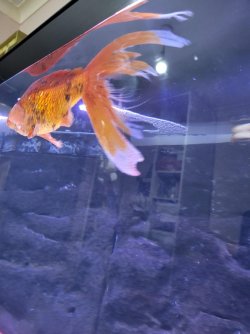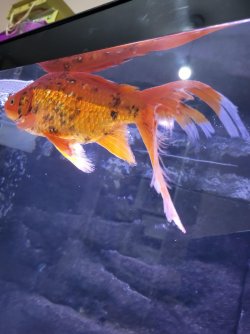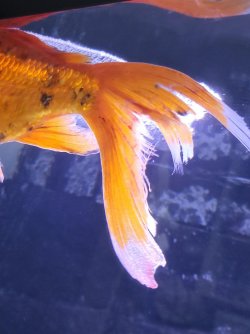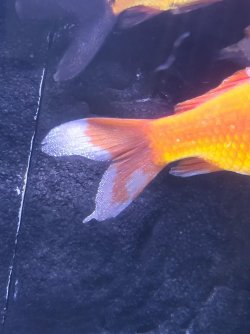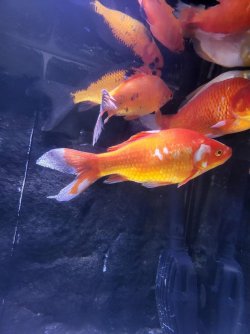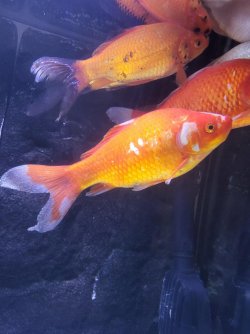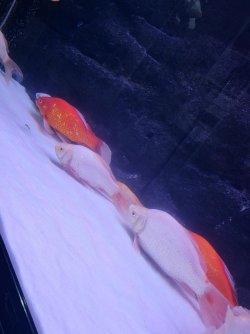Was your aquarium set up before you got the fish?
Did you dechlorinate the tap water in the aquarium so it was free of chlorine/ chloramine?
Is there a filter on the aquarium?
Is the filter cycled/ established and have a colony of good bacteria to keep ammonia, nitrite at 0ppm.
Did the fish have damaged fins and white stuff on the fins when you got them or did that develop in your tank?
--------------------
Stop adding chemical medications.
The creamy white slime on the fish is excess mucous caused by something in the water irritating the fish.
The damaged tails have fin rot, which is caused by poor water quality allowing harmful bacteria into the damaged tissue where it destroys the tail and fins.
The black marks on the fish are ammonia or chemical burns, probably ammonia burns because the fish also have fin rot and excess mucous. These often go together in a newly set up tank without an established biological filter. If the previous owner moved the fish out of a big pond and put them all in a small tank, and they didn't have a filter on that tank, the fish probably suffered from ammonia poisoning at the seller's place.
Treatment is clean water and salt. If the damaged fins get infected and don't heal up with salt, you will need a broad spectrum medication that kills bacteria and fungus (preferably not antibiotics).
--------------------
WHAT TO DO NOW.
Test the water for ammonia, nitrite, nitrate and pH. Post the results in numbers here.
Wipe the inside of the glass down with a clean fish sponge. This removes the biofilm on the glass and the biofilm will contain lots of harmful bacteria, fungus, protozoans and various other microscopic life forms.
Do a 75% water change and gravel clean the substrate every day for a week. The water changes and gravel cleaning will reduce the number of disease organisms in the water and provide a cleaner environment for the fish to recover in. It also removes a lot of the gunk and this means any medication can work on treating the fish instead of being wasted killing the pathogens in the gunk.
Make sure any new water is free of chlorine/ chloramine before it is added to the tank.
Clean the filter if it hasn't been done in the last 2 weeks. However, if the filter is less than 6 weeks old, do not clean it. Wash the filter materials/ media in a bucket of tank water and re-use the media. Tip the bucket of dirty water on the garden/ lawn. Cleaning the filter means less gunk and cleaner water with fewer pathogens so any medication (if needed) will work more effectively on the fish.
Increase surface turbulence/ aeration to maximise the dissolved oxygen in the water.
Add some salt, (see directions below).
--------------------
SALT
You can add rock salt (often sold as aquarium salt), swimming pool salt, or any non iodised salt (sodium chloride) to the aquarium at the dose rate of 1 heaped tablespoon per 20 litres of water. If there is no improvement after 48 hours you can double that dose rate so there is 2 heaped tablespoons of salt per 20 litres.
If you only have livebearers (guppies, platies, swordtails, mollies), goldfish or rainbowfish in the tank you can double that dose rate, so you would add 2 heaped tablespoons per 20 litres and if there is no improvement after 48 hours, then increase it so there is a total of 4 heaped tablespoons of salt per 20 litres.
Keep the salt level like this for at least 2 weeks but no longer than 4 weeks otherwise kidney damage can occur. Kidney damage is more likely to occur in fish from soft water (tetras, Corydoras, angelfish, Bettas & gouramis, loaches) that are exposed to high levels of salt for an extended period of time, and is not an issue with livebearers, rainbowfish or other salt tolerant species.
The salt will not affect the beneficial filter bacteria but the higher dose rate (4 heaped tablespoons per 20 litres) will affect some plants and some snails. The lower dose rate (1-2 heaped tablespoons per 20 litres) will not affect fish, plants, shrimp or snails.
After you use salt and the fish have recovered, you do a 10% water change each day for a week using only fresh water that has been dechlorinated. Then do a 20% water change each day for a week. Then you can do bigger water changes after that. This dilutes the salt out of the tank slowly so it doesn't harm the fish.
If you do water changes while using salt, you need to treat the new water with salt before adding it to the tank. This will keep the salt level stable in the tank and minimise stress on the fish.
When you first add salt, add the salt to a small bucket of tank water and dissolve the salt. Then slowly pour the salt water into the tank near the filter outlet. Add the salt over a couple of minutes.


